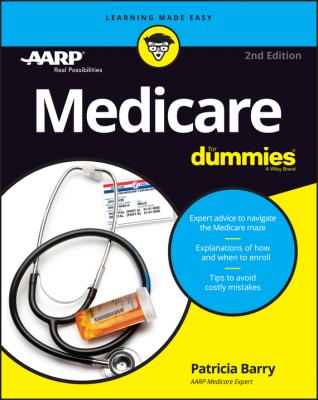Medicare For Dummies. Barry Patricia
Чтение книги онлайн.
Читать онлайн книгу Medicare For Dummies - Barry Patricia страница 8
 Prescribed by a doctor or another primary care professional
Prescribed by a doctor or another primary care professional
❯❯ Not easily used by anyone who isn’t ill or injured
❯❯ Reusable and likely to last for three years or more
❯❯ Appropriate for use within the home
❯❯ Provided by suppliers that Medicare has approved
Durable equipment that Medicare covers includes walkers and crutches; scooters and manual and powered wheelchairs; commode chairs; hospital beds; respiratory assistance devices; pacemakers; artificial limbs and eyes (prosthetics); limb, neck, and back braces (orthotics); and many other items. Medicare also covers some supplies, such as diabetic test strips and lancets, but not disposable items, such as catheters and diapers.
Medical equipment is most often rented, but some items may be purchased. In either case, Medicare Part B pays 80 percent, and you pay the remaining 20 percent (unless you have Medigap insurance that covers your share). That’s the breakdown in traditional Medicare if you use a supplier that accepts the Medicare-approved amount as full payment. Otherwise, you pay whatever the supplier asks. If you’re in a Medicare Advantage plan, coverage is the same, but you may have different co-pays; check with your plan for details.
Part D, Medicare’s program for covering prescription drugs, is a complicated benefit that resembles no other type of drug coverage ever devised. That’s why understanding how it works before plunging in is really important. This section focuses on the peculiarities of Part D coverage – how it can fluctuate during the year, how different plans have their own lists of drugs they cover, and which drugs are excluded from Part D and which must be covered.
Making sense of drug coverage that can vary throughout the year
❯❯ Phase 1, the annual deductible: If your Part D drug plan has a deductible, you must pay full price for your drugs until the cost reaches a limit set by law ($320 in 2015; $360 in 2016) and drug coverage actually begins. Many plans don’t charge deductibles or charge less than the limit. But if your plan has a deductible, this period begins on January 1 or whenever you start using your Medicare drug coverage.
❯❯ Phase 2, the initial coverage period: This stage begins when you’ve met any plan deductible. Otherwise, it begins on January 1 or whenever you start using Medicare drug coverage. You then pay the co-payments required by your plan for each prescription, and the plan pays the rest. This period ends when the total cost of your drugs – what you’ve paid plus what your plan has paid – reaches a certain dollar limit set in law ($2,960 in 2015; $3,310 in 2016).
❯❯ Phase 3, the coverage gap: This gap – often called the doughnut hole – begins when you hit the limit of initial coverage and ends if and when the amount you’ve spent out-of-pocket on drugs from the beginning of the year hits another dollar limit set in law ($4,700 in 2015; $4,850 in 2016).
Until 2011, you would’ve had to pay 100 percent of the cost of your drugs in the gap. Now you pay a lot less because under the Affordable Care Act, the gap is gradually shrinking. In 2015 and 2016, you get a discount of 55 percent on brand-name drugs in the gap. For generic drugs, you get a discount of 35 percent in 2015 and 42 percent in 2016. These discounts, which come partly from the drug manufacturers and partly from the government, get larger until by 2020, you pay no more than 25 percent of the cost of any drugs in the gap. What’s more, the manufacturers’ discounts on brand-name drugs count toward the dollar out-of-pocket limit that gets you out of the gap; that is, you get credit for having paid full price even though you’re receiving the discount. But for any discounts funded by the government, such as those for all generic drugs, only what you pay counts toward getting out of the gap. (I explain the gap in more detail in Chapter 14.)
❯❯ Phase 4, catastrophic coverage: If your drug costs are high enough to take you through the gap, coverage kicks in again. At this point, your share of the costs drops sharply. You pay no more than 5 percent of the price of each prescription. Catastrophic coverage ends on December 31. The next day, January 1, you return to Phase 1 (or Phase 2 if your plan has no deductible), and the whole cycle starts over again.
Figure 2-1 is a quick way of looking at the same cycle of coverage.
© John Wiley & Sons, Inc.
FIGURE 2-1: Phases of Part D drug coverage and dollar limits.
Figure 2-2 shows this information in a different way. Here, you can see examples of brand-name drugs costing (for the sake of simplicity) $100, $200, or $300 per one-month prescription – and what you’d pay for them in each phase of coverage. These examples assume co-pays during the initial coverage period of $45 for each prescription, although co-pays vary widely among Part D plans.
© John Wiley & Sons, Inc.
FIGURE 2-2: Examples of costs through four phases of coverage.
Finding out about formularies
❯❯ You usually have to pay the whole tab for drugs that aren’t covered. Your plan pays its share of the cost during the initial and catastrophic coverage phases (Phases 2 and 4). But for any drug the plan doesn’t cover, you pay full price in all phases of coverage unless you win an exception from the plan. (I explain about coverage exceptions in Chapter 14.) The difference in your out-of-pocket expenses